*Updated 3/15/24
Okay, so you’ve decided to take the plunge into the adventuring world with your cat. What’s the first step? Do you just pack up the car and head out on a camping trip with him? Unfortunately, no. Your kitty will need to be trained and work up to those big-time adventures. The first step is cat harness training.
I can’t stress enough that training your cat takes time and patience. Sure, there will always be the exceptions – the cats who are just naturally up for anything without much training. That isn’t the norm though. Take the time to train your cat properly, however long it takes, and things will go more smoothly for both of you.
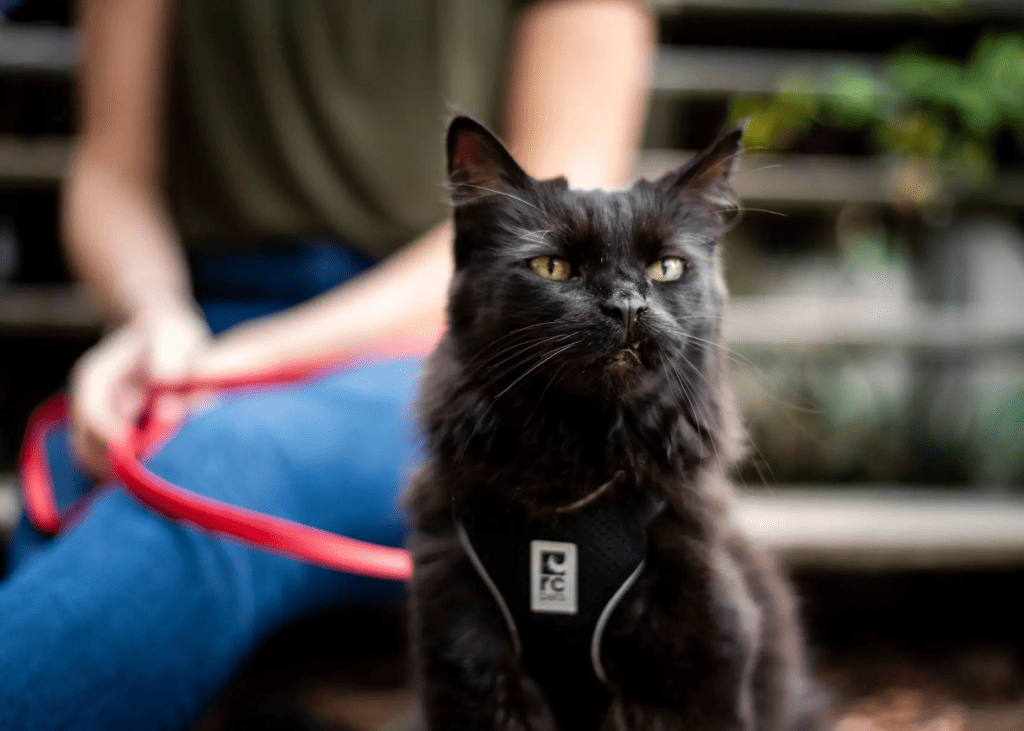
*Disclosure: This post contains affiliate links. If you make a purchase using one of these links, I will receive a small commission at no extra cost to you. This helps me to continue creating helpful content. Don’t worry – I would never recommend something I don’t like or use myself!
Why You Should Harness & Leash Train Your Cat
Here at KittyCatGO, we believe that enriching your cat’s life with adventure, big or small, will help to give your cat a more fulfilled life. Cat harness training allows your cat to experience the sights, smells, and sounds of the outside world in a safe way and brings joy and excitement to their life they can’t otherwise experience.
Training together will also grow trust, and trust breeds a stronger bond. And don’t we all want a stronger bond with our kitties?
Even if you don’t have grand plans to hike or camp with your cat, harness training your cat has many practical applications.
- Going to the vet
- Emergency situations (for example, having to evacuate your home in a situation where having your cat in a carrier isn’t practical)
- Traveling in the car (you can let your cat out to stretch their legs)
- Just hanging out in the back yard
Now you may be thinking, “Why can’t I just let my cat free-roam outside?” Letting your cat outdoors unsupervised and without a harness and leash is not something I recommend for a few reasons:
- There are many dangers, including cars, predators, other cats, poisons and toxins, humans, etc.
- Your cat is a danger to other wildlife, such as chipmunks and birds.
- Your cat could become an unwanted visitor at a neighbor’s house.
- Most people don’t like it when dogs roam free, and it’s actually illegal in many places. Why should cats be allowed to?
Simply put, harness and leash training your cat is a great way to let them experience the outside in a safe and controlled manner.
Picking Out a Cat Harness
Before you start harness training your cat, you’ll need to figure out what kind of cat harness to get. You’ll definitely want to get a harness rather than a collar because it is unsafe to leash-walk a cat with just a collar. Walking a cat that way can lead to choking or injury to your cat’s throat.
There are several types of cat harnesses out there. Popular harness styles include the Roman harness, the step-in harness, and the walking vest or walking jacket. Each have their own pros and cons, and what works best for one cat might not be what works best for yours.
You will likely need to buy a couple different ones to figure out which is best for your kitty. Check out our Cat Harness Style Guide for more information on the different cat harness styles.
Picking out a Cat Leash
There are many different leashes on the market. Retractable leashes, bungee leashes, braided leashes, nylon leashes… the list goes on. A basic 6 foot leash is the best kind to start your cat leash training though.
These leashes are lightweight, which is what you want in a cat leash. The length is ideal as well. You don’t want something too long, especially when you’re first starting out. A shorter length gives you more control and keeps your cat close by.

Cat Harness Training Steps
Once you’ve picked out a harness and leash, it’s time to begin the cat harness training process! If your cat has never worn a harness before, the first step is to get them used to wearing one. Once you’ve purchased a well-fitting and secure harness, take it slowly and follow these steps:
Step 1 – Introduce the harness to your cat.
Contrary to popular belief, the first step to harness training your cat is NOT to put the harness on them. You must first let your cat discover the harness on their own and begin to associate it with positive things right from the start.
Leave the harness out, and let your cat smell it. Reward your kitty with treats for expressing interest in the harness. You should repeat this step several times over multiple days before moving on to Step 2.
Step 2 – Make sure your cat is comfortable with handling and touch.
To be able to put a harness on your cat, your cat has to be comfortable with you touching and handling them. If your cat isn’t already okay with that, you can start pairing your touch with a positive reward (treats). Touch your cat’s back, sides, and even their belly, then feed them a treat.
You can start with short, quick touches and gradually work up to longer strokes and touches.
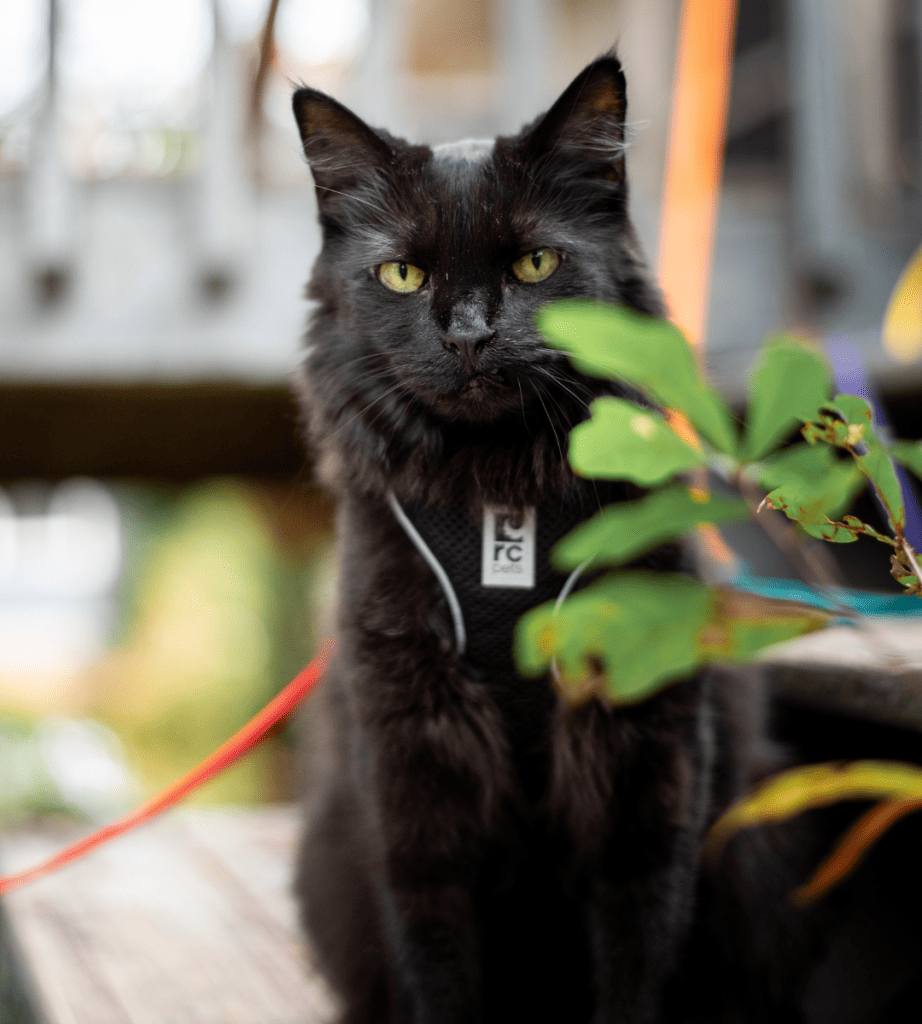
Looking for help with cat harness training?
My online cat harness and leash training course is 100% self-paced and includes bite-sized lessons that walk you through every step of the process – from choosing a harness to introducing your cat to the outdoors.
And you have direct access to a certified cat trainer if you have any questions or need any help along the way.
Step 3 – Get your cat comfortable with the sounds of the harness.
Many cat harnesses have velcro or buckle straps. The sound of velcro especially can be startling to some cats, so just as you began making positive associations with the presence of the harness, you can do the same with the sounds of the harness.
Fasten and unfasten the harness straps, then give your cat a treat. Repeat this step until your cat is comfortable with the various harness sounds.
Step 4 – Place the harness on your cat.
It’s time to try putting the harness on your cat – but don’t buckle or fasten it. Just touch it to their back and sides, and eventually lay it on top of them. After each touch of the harness, reward with treats.
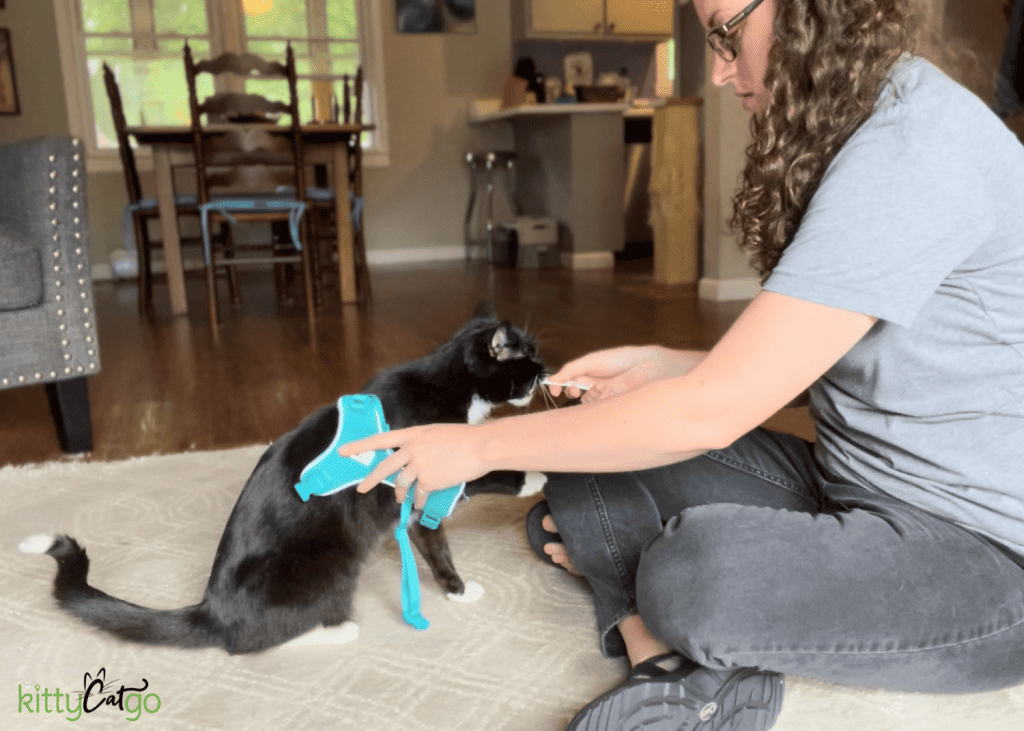
When it comes to laying the harness on your cat, it helps if you do this while they’re eating a meal, some treats, or engaging with a snuffle mat or licky mat so they are distracted by something delicious. These tasty distractions also help your cat to further associate the harness with good things!
Repeat this step as many times or as many days as necessary until your cat is comfortable with the harness lying on their backs.
Step 5 – Fasten the harness.
Once your cat is accepting of the harness touching and lying on their back, you can try fastening it. Most harnesses have both a neck strap and a belly/girth strap. Start with the neck strap – put it on, fasten it, remove after a couple seconds, and reward with treats. Repeat this step a few times, then do the same with the belly/girth strap.
You can also use the distraction of meal times and snuffle/licky mats like in Step 4.
If at first you can only get the neck strap fastened, that’s okay! Start there, and try fastening just the girth strap next time. Then eventually you can work up to getting both straps fastened.
Once you’re able to fasten both straps, you can practice adjusting the fit. You don’t want it to be too tight or restrictive, but you don’t want it too loose either. You should be able to fit one-finger-width between the harness and your cat.
Let your cat wear the harness for small increments of time – maybe just 1-2 minutes. Again, reward with treats, even if they just lie there.
WARNING: It is completely normal for some cats to react negatively to the harness at first. They may flop over, freeze up and refuse to move, or act wildly. Think about how you would feel if you had never worn clothes before and then put a shirt on for the first time. It would feel weird!
Be patient. There is no set time frame for how long this process should take. It could be days, weeks, months… It’s important that you go at your cat’s pace and not force anything. And always reward with treats and praise!
Step 6 – Encourage your cat to move and be active.
Once your cat is comfortable wearing the harness for small increments of time, you can start to encourage them to move, walk, and play while wearing it.
Entice them with toys and treats. Have clicker training sessions while they wear it. Just do their regular activities with them while they wear it.
Gradually increase the amount of time your cat wears the harness. The goal is to get them comfortable wearing it and moving around in it so they don’t even notice it’s there.
Note: Never leave the harness on your cat if they will be unattended. Harnesses can quickly become safety hazards if your cat were to get stuck or snagged on something, so always remove the harness if you won’t be present.
Reminders
Depending on your cat, you may need to spend more time on Steps 1, 2, 3, 4, or 5 before moving on to the next step.
If one step doesn’t seem to be going very well, go back to the previous step and repeat. This happens sometimes, and IT’S OKAY!
No matter how much time you have to spend on a step, always be sure to praise your cat and reward them with treats for their progress.
Remember too that this isn’t a race. Take your time, don’t force anything, and follow your cat’s lead.
Cat Harness Training Video Tutorial
Watch this video for a demonstration of the cat harness training process:
Cat Leash Training Steps
Once your cat is comfortable wearing their harness around the house, it’s time to add the leash to the equation!
Step 1 – Let your cat inspect the leash.
Just as you did with the harness, you want to slowly introduce the leash to your cat. Lay it out on the floor for them to investigate. Toss down some treats to encourage them to discover it and interact with it.
Step 2 – Attach the leash inside.
From the comfort of inside your home, put your cat’s harness on and attach the leash. Keep the leash in your hand and follow your cat around, allowing them to freely explore and do their own thing.
Don’t tug on the leash or try to guide your cat. Also avoid letting the leash drag on the ground, as that can be frightening.
Praise and reward with treats.
Step 3 – Learn how to handle the leash.
Before you go further in your cat’s training, you want to make sure YOU understand how to properly handle the leash. The way you handle the leash is arguably one of the biggest factors in whether or not your cat is able to escape their harness.
Once you’ve attached the leash to your cat’s harness, you always want to make sure you are positioned behind your cat so there is no forward tension on the leash. If there is leash tension pulling forward, your cat will be much more likely to be able to slip backwards out of their harness to escape.
This graphic is a good illustration of how to properly position yourself and the leash in relation to your cat so you can more effectively prevent harness escapes:
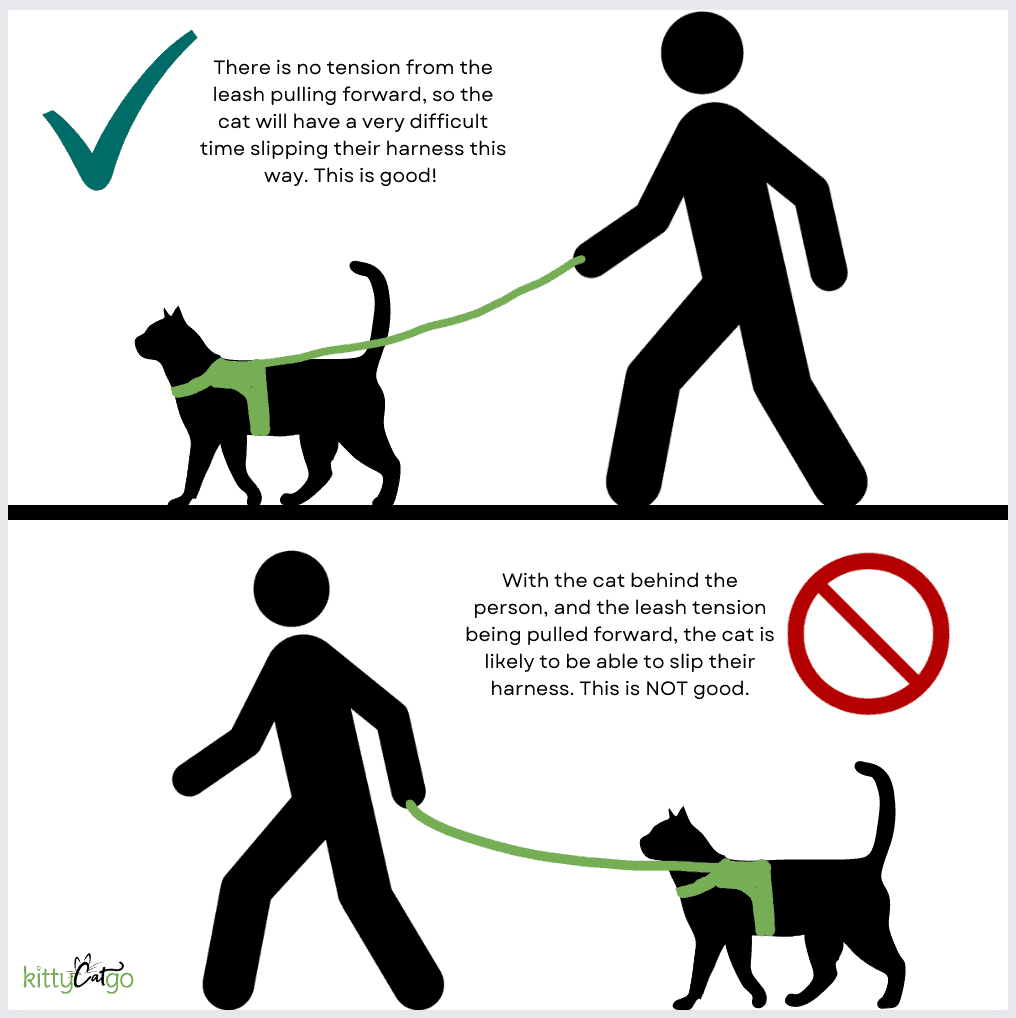
You should also always maintain some slack in the leash. If the leash is pulled taut, your cat will more easily be able to gain the leverage needed to back out of their harness.
Step 4 – Encourage your cat to walk around.
Once your cat is comfortable with the weight and feel of the attached leash, you can begin to encourage them to walk around more. There are a few ways you can do this…
- With a treat trail! Drop treats on the ground for your cat
- With a target stick or finger target! If your cat is target trained, you can use either your target stick or finger to lure them around.
- With a wand toy or lure! Grab your cat’s favorite wand toy and lead them around the house.
The goal of this step is just to get your cat comfortable moving and walking around INSIDE while wearing their harness and leash. It is also good practice for encouraging your cat to walk in a specific direction.
Step 5 – Practice your cat’s recall.
Before you take things outside, you want to work on your cat’s recall.
Basic recall training steps:
- Say your cat’s name and give them a high-value treat.
- Toss a treat a few feet away from you. When your cat has finished eating it, say their name and reward when they return to you.
- Increase the distance between you and your cat. Start with 5-6 feet, then 8-10, then try going into a different room and calling them. Always reward when they return to you.
- Start pairing this action with a cue word, such as “Come.” Continue rewarding when your cat returns to you.
- Add in the harness and leash. With their harness and leash on (still inside), take a few steps away from your cat and give your recall cue word. Reward.
- Still with the harness and leash on, repeat step 3. You will drop the leash and let your cat drag it behind them as you increase your distance. The dragging leash may make your cat nervous at first, but it’s important to get them used to the feeling in case you ever drop their leash when outside.
Step 6 – Open the door.
The final step of the indoor leash training phase is to introduce your cat to the outside world, but from the comfort and safety of their inside world. For this step, your cat should be wearing their harness with the leash attached. You will also want to have their favorite high-value treats handy.
Pick the door of your house that leads to the quietest outdoor area possible. This could be the door that opens up to your back yard or back porch. If you live in an apartment building, you can use a door that might lead to a porch or balcony, or the door that leads out to the hallway outside your apartment.
With your cat securely harnessed and leashed, open the door and sit with your cat just inside the door. Give them treats and let them start getting a sense for what’s on the other side of the door. You don’t want them to cross the threshold quite yet – you’re just piquing their curiosity and giving them a taste of the sights, smells, and sounds that are found outside.
Keep the door open for just a minute or two, then close it and reward with treats. Repeat this step, and as your cat grows more comfortable, gradually increase the amount of time the door remains open.
Step 7 – Take it outside.
Once you are confident your cat is comfortable with both their harness and leash, it’s finally time to take things outside! Gear up, and head out your door with cat and treats in hand.
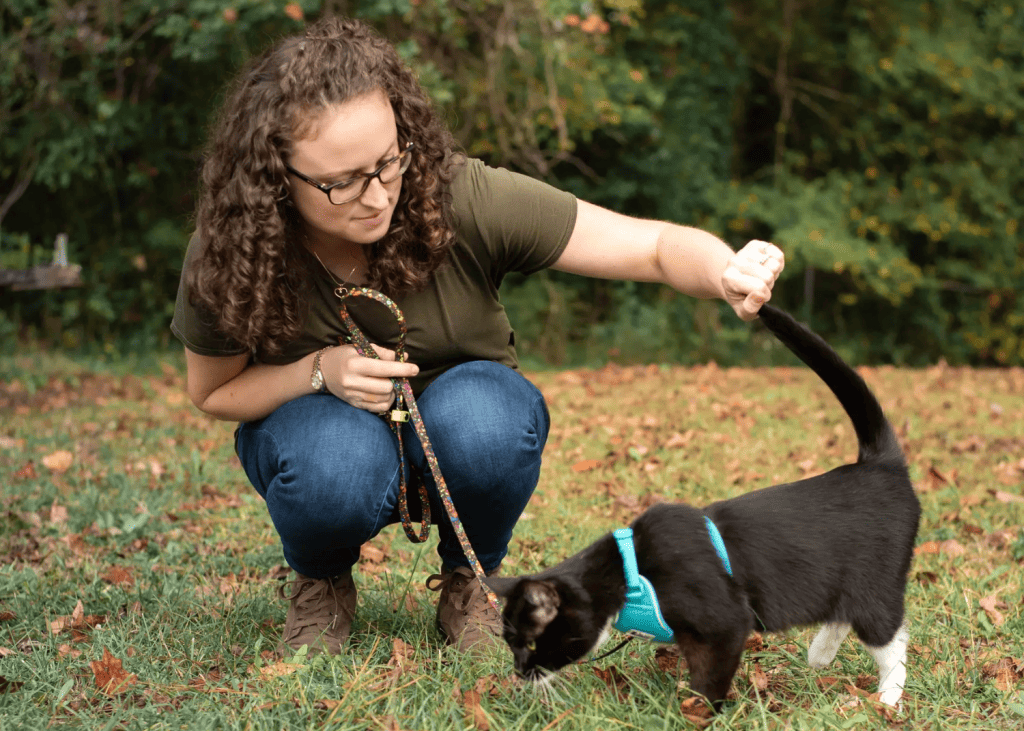
Choose the door that leads to the quietest area possible, such as the one to your back yard. If you live in an apartment building, I’d recommend starting in the hallway outside your door.
Be sure to carry your cat out the door so they don’t learn they can cross the threshold themselves – this (among other things) helps prevent future door-dashing.
Take just a step or two outside your door and put your cat down. If you’re able, leave your door open so you can quickly and easily get back inside if necessary.
Understand that if this is your cat’s first time outdoors, they might quickly be overwhelmed or stressed. Give them some treats, pets, and praise to reassure them and to create a positive experience, but if they seem too overwhelmed, go back inside and try again another time.
Repeat this process, never going further than a couple steps from your door. You want to be able to quickly retreat back inside if needed.
These outdoor trips shouldn’t be more than a couple minutes long. You are gradually introducing your cat to the outdoors, so take things slowly and pay attention to their body language.
Cat Leash Training Video Tutorial
Additional Tips for Cat Leash Training
- If your cat’s regular treats don’t seem to be motivating them very well, try something new – a “special” treat that’s just for training. It could be a higher quality treat, freeze-dried treats, pieces of meat, whatever. Sometimes cats need a little extra motivation, and a new, special treat can do the trick.
- Never leave your cat’s harness and/or leash on them if they will be unsupervised. Leashes and harnesses can get snagged on things, possibly causing injury to your kitty. If you won’t be around to keep an eye on them, remove the leash and harness.
- After your cat is leashed and harnessed, always carry them outside. Don’t let them walk out the door on their own. If your cat gets used to walking out the door, they may dash for it when you come and go. You don’t want that!
- Walking your cat isn’t going to be like walking a dog. While cats will walk a trail and keep a steady pace sometimes, they also tend meander. If you go into this training experience expecting it to be like walking a dog, you will likely be disappointed. Try not to have any expectations, and just go with the flow.
- Take things slowly, and watch your cat for any cues that they are scared or uncomfortable. Follow their lead, and don’t force them to do things on your timeline. Be patient. You always want your training sessions to be positive experiences for them.
- Remember that the amount of time spent on each training step is going to be dependent on your cat. Every cat is different. You may have one cat that flies through the steps and another that takes weeks or even months to progress through the steps. Patience and knowing your cat are key.

Looking for help with cat harness training?
My online cat harness and leash training course is 100% self-paced and includes bite-sized lessons that walk you through every step of the process – from choosing a harness to introducing your cat to the outdoors.
And you have direct access to a certified cat trainer if you have any questions or need any help along the way.
Have you started the cat harness training process yet? I’d love to hear how it’s going! Drop a comment down below and let me know where you are in the process.
About the Author

Emily Hall, ABCCT is a certified cat trainer and cat adventure enthusiast. As a “mom” to seven cats and one dog, she has been writing in the pet industry for 10 years, with a focus on traveling and adventuring with cats. Emily has a passion for getting out there and doing more with her cats – for pushing the bounds of cat expectations! She and her husband enjoy hiking, road-tripping, camping, and canoeing with their three cat adventurers. Read more about Emily here.


I have a step in harness for each of my two Bengals (Pip & Squeak… almost 3 years old). With start to get them used to it slowly as suggested. Thanks!